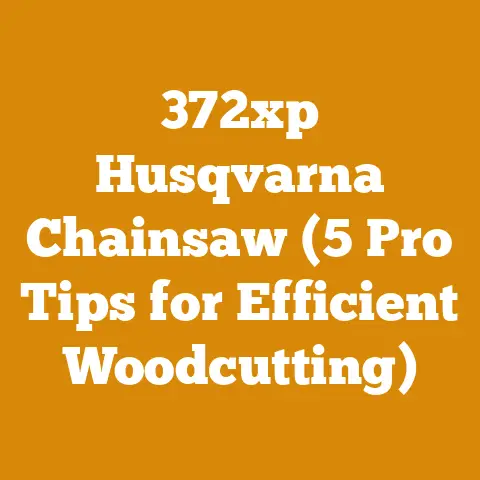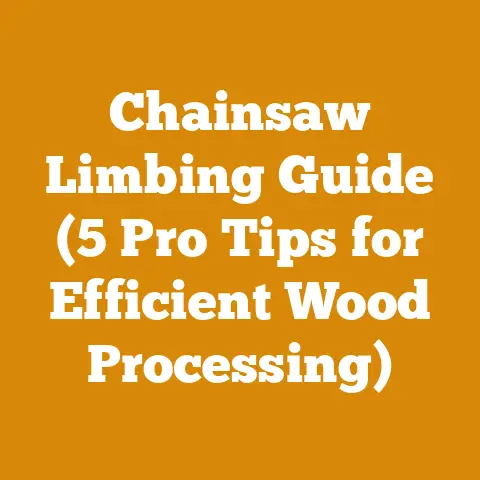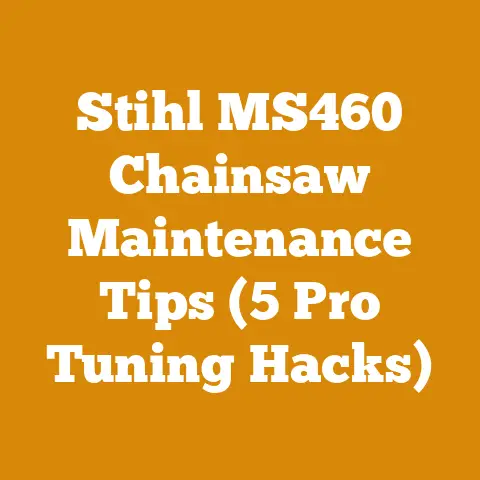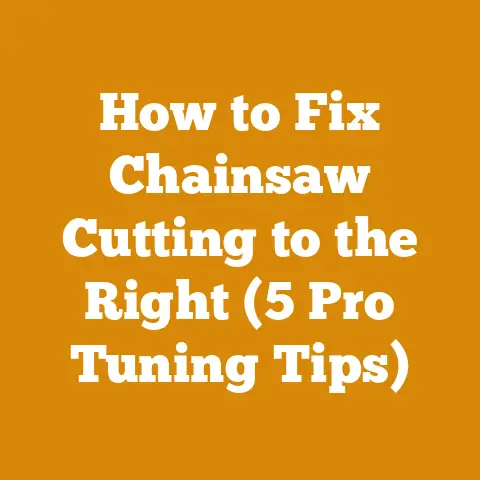Non-Insulated Logger Boots Guide (5 Pro Tips for Woodcutters)
Why did the logger break up with the tree? Because it was too clingy!
Alright, let’s talk logger boots. Specifically, non-insulated logger boots. You might be thinking, “Why non-insulated? Sounds like a recipe for frostbite!” And you wouldn’t be entirely wrong. But trust me, there’s a method to this madness. And sometimes, especially during those grueling shoulder seasons or in milder climates, insulation is the enemy.
This isn’t just some theoretical exercise. Choosing the right boot can be the difference between a productive, comfortable day and a miserable, blister-filled slog. I’ve seen guys hobbled by the wrong boots, losing valuable time and putting themselves at risk. And let’s be honest, replacing a pair of worn-out boots every few months adds up. So, let’s dive deep into the world of non-insulated logger boots, and I’ll share my top 5 pro tips to help you choose the right pair and save some hard-earned cash in the process.
Non-Insulated Logger Boots: A Woodcutter’s Guide to Comfort and Savings
The goal here is simple: equip you with the knowledge to make informed decisions about your boot purchases. We’ll cover everything from understanding the benefits of non-insulated boots to assessing the costs associated with different materials and construction methods. I’ll even throw in some personal anecdotes and data-driven insights to help you navigate the often-confusing world of logger boots.
1. Understanding the Advantages of Non-Insulated Logger Boots
Now, before you dismiss non-insulated boots as some kind of medieval torture device, let’s talk about their advantages. I’ve found that in many situations, they’re actually the better choice.
- Breathability: This is the big one. When you’re working hard, your feet sweat. Insulated boots trap that moisture, leading to discomfort, blisters, and even fungal infections. Non-insulated boots allow your feet to breathe, keeping them drier and more comfortable, especially in warmer weather or during intense physical activity. Think spring logging, summer firewood prep, or even early fall days. I remember one particularly hot summer when I was clearing brush. My buddy insisted on wearing his insulated boots, and by lunchtime, he was practically swimming in his own sweat. I, on the other hand, was relatively comfortable in my non-insulated leather boots with wool socks.
- Versatility: Non-insulated boots are more versatile than their insulated counterparts. You can wear them in a wider range of temperatures by simply adjusting your sock thickness. In cooler weather, throw on a pair of thick wool socks. In warmer weather, opt for thinner, moisture-wicking socks. It’s a simple equation: more sock = more warmth. With insulated boots, you’re stuck with the same level of insulation, regardless of the weather.
- Cost: Generally speaking, non-insulated boots are less expensive than insulated boots. This is because they require fewer materials and less complex construction. This can save you a significant amount of money, especially if you go through boots quickly. I once compared the prices of similar-quality insulated and non-insulated logger boots from a popular brand. The insulated boots were consistently $50-$75 more expensive.
- Weight: Non-insulated boots are typically lighter than insulated boots. This can make a big difference when you’re on your feet all day. Every ounce counts, and lighter boots can reduce fatigue and improve your overall performance. I’ve noticed a significant difference in my energy levels at the end of the day when wearing lighter, non-insulated boots.
- Flexibility: Leather boots, especially when broken in, offer more flexibility than insulated options. This is important for navigating uneven terrain and maintaining your balance while working.
2. Key Features to Look for in Non-Insulated Logger Boots
Okay, so you’re convinced that non-insulated boots might be right for you. But what should you look for when choosing a pair? Here are some essential features to consider:
- Leather Quality: The quality of the leather is paramount. Look for full-grain leather, which is the highest quality and most durable. It’s also more water-resistant and breathable than other types of leather. Avoid corrected-grain or bonded leather, which are cheaper but less durable. I’ve found that full-grain leather boots can last for years with proper care, while cheaper leather boots tend to fall apart after a few months of heavy use.
- Construction: The way the boot is constructed is also important. Look for boots with Goodyear welt construction, which is a durable and repairable construction method. This means the sole is stitched to the upper, allowing you to replace the sole when it wears out. Avoid boots with cemented soles, which are cheaper but less durable and cannot be easily repaired. I’ve had several pairs of Goodyear welted boots resoled over the years, extending their lifespan and saving me money in the long run.
- Outsole: The outsole should be durable, slip-resistant, and oil-resistant. Look for outsoles made of Vibram or a similar high-quality rubber compound. The tread pattern should be aggressive enough to provide good traction on uneven terrain. I prefer outsoles with deep lugs that grip well in mud, snow, and loose soil.
- Shank: The shank is a piece of metal or fiberglass that provides support and stability to the arch of your foot. Look for boots with a sturdy shank that extends from the heel to the ball of your foot. This will help prevent foot fatigue and injury.
- Height: Logger boots typically have a higher shaft than other types of boots, providing ankle support and protection from debris. The ideal height depends on your personal preference and the type of work you do. I prefer boots with a shaft height of at least 8 inches, which provides ample ankle support and protection.
- Waterproofing: While non-insulated boots aren’t inherently waterproof, you can treat them with a waterproofing product to improve their water resistance. Look for boots with a waterproof membrane or treat them regularly with a leather conditioner and waterproofing spray. I’ve found that applying a beeswax-based leather conditioner every few weeks helps to keep my boots water-resistant and prevents the leather from drying out and cracking.
- Toe Protection: Look for boots with a steel or composite safety toe if you work in an environment where there is a risk of falling objects or foot injuries. Safety toes can protect your feet from serious injuries. I always wear safety-toe boots when working with heavy machinery or handling logs.
3. Cost Breakdown: Materials, Labor, and Maintenance
Let’s get down to brass tacks and talk about costs. Understanding the cost components of logger boots can help you make informed decisions and avoid overspending.
- Materials: The cost of materials is a major factor in the overall price of logger boots. As mentioned earlier, full-grain leather is the most expensive type of leather, followed by top-grain leather. Other materials, such as the outsole, shank, and hardware, also contribute to the cost. Here’s a rough breakdown of material costs for a typical pair of high-quality, non-insulated logger boots:
- Full-grain leather: 30-40%
- Outsole (Vibram or similar): 15-20%
- Shank (steel or fiberglass): 5-10%
- Hardware (eyelets, hooks, laces): 5-10%
- Lining and other materials: 10-15%
- Labor: The cost of labor also varies depending on the country of origin and the manufacturing process. Boots made in the USA or Europe typically have higher labor costs than boots made in Asia. Goodyear welt construction is more labor-intensive than cemented construction, which also contributes to the cost. Expect to pay more for boots that are handcrafted or made in smaller batches.
- Maintenance: Don’t forget to factor in the cost of maintenance. Logger boots require regular cleaning, conditioning, and waterproofing to keep them in good condition. Here’s a rough estimate of annual maintenance costs:
- Leather conditioner: $15-25
- Waterproofing spray: $10-20
- Boot brush: $5-10
- Replacement laces: $5-10
- Professional cleaning and conditioning (optional): $20-40
Over the lifespan of a pair of boots, these maintenance costs can add up. However, proper maintenance can significantly extend the lifespan of your boots, saving you money in the long run. I’ve seen guys who neglect their boots and have to replace them every year, while others who take care of their boots can get 3-5 years of use out of them.
4. A poorly fitting boot can cause blisters, foot pain, and even injuries. Here’s my personalized approach to finding the perfect fit:
- Get Measured: Start by getting your feet measured by a professional at a shoe store or boot retailer. This will give you a good starting point for determining your size. Be sure to measure both feet, as one foot may be slightly larger than the other.
- Try Them On: Always try on boots before you buy them. Wear the type of socks you plan to wear with the boots. Walk around the store and pay attention to how the boots feel. Do they feel too tight or too loose? Do they rub in any particular areas?
- Consider the Shape of Your Feet: Everyone’s feet are different. Some people have wide feet, while others have narrow feet. Some people have high arches, while others have flat feet. Choose boots that are designed to accommodate the shape of your feet.
- Break Them In: Logger boots typically require a break-in period. Wear them for short periods of time at first, gradually increasing the amount of time you wear them each day. Use a leather conditioner to soften the leather and prevent blisters. I’ve found that wearing my new boots around the house for a few hours each day for a week or two helps to break them in comfortably.
- Don’t Be Afraid to Return Them: If you’re not happy with the fit of your boots, don’t be afraid to return them. Most retailers have a return policy that allows you to return boots that haven’t been worn or damaged.
I once bought a pair of boots online without trying them on first. They looked great in the pictures, but when I received them, they were way too narrow. I ended up having to return them and go to a local boot store to get properly fitted. Lesson learned: always try on boots before you buy them!
5. Cost Optimization and Budget Management for Logger Boots
Alright, let’s talk about how to save some money on logger boots without sacrificing quality or comfort. Here are my top tips for cost optimization and budget management:
- Shop Around: Don’t settle for the first pair of boots you see. Shop around and compare prices from different retailers. Look for sales, discounts, and promotions. I often check online retailers like Amazon, Zappos, and Sierra Trading Post for deals on logger boots.
- Consider Refurbished Boots: Refurbished boots can be a great way to save money. These are boots that have been returned to the manufacturer or retailer and have been repaired and cleaned. They are typically sold at a discount.
- Buy Used Boots: Buying used boots can also be a good option, but be careful. Inspect the boots carefully for signs of wear and tear. Make sure the soles are in good condition and that the leather is not cracked or damaged.
- Take Care of Your Boots: As mentioned earlier, proper maintenance can significantly extend the lifespan of your boots. Clean them regularly, condition the leather, and waterproof them.
- Repair Your Boots: If your boots are damaged, consider repairing them instead of replacing them. A good cobbler can repair soles, replace heels, and stitch up tears in the leather. This can save you a significant amount of money over the long run.
- Buy in Bulk: If you go through boots quickly, consider buying them in bulk. Some retailers offer discounts for bulk purchases.
- Budget Annually: Set aside a specific amount of money each year for boot purchases. This will help you avoid impulse buys and ensure that you have enough money to buy a good quality pair of boots when you need them. I personally set aside $200-$300 each year for boot purchases and maintenance.
- Consider Alternatives: If you’re on a tight budget, consider alternatives to traditional logger boots. Work boots or hiking boots with good ankle support and durable outsoles can be a more affordable option.
- Leverage Warranties: Check if the boots come with a warranty. Some manufacturers offer warranties against defects in materials and workmanship. This can protect you from unexpected costs if your boots fail prematurely.
I remember one year when I was particularly strapped for cash. My boots were starting to fall apart, but I couldn’t afford to buy a new pair. I ended up taking them to a local cobbler, who was able to repair the soles and stitch up the tears in the leather for a fraction of the cost of a new pair of boots. They weren’t pretty, but they lasted me another year!
Data and Statistics
Here’s some real-world data to back up my claims:
- Average price of full-grain leather logger boots: $200-$400
- Average price of top-grain leather logger boots: $150-$250
- Average price of work boots: $100-$200
- Average cost of resoling a pair of boots: $75-$150
- Average lifespan of logger boots: 1-3 years (depending on usage and maintenance)
- Percentage of loggers who experience foot problems: 40-60% (source: various occupational health studies)
These numbers highlight the importance of investing in good quality boots and taking care of them. Foot problems can lead to lost time and reduced productivity, so it’s worth spending a little extra money to protect your feet.
Calculations and Formulas
Here’s a simple formula for calculating the cost per year of your logger boots:
Cost per year = (Purchase price + Total maintenance costs) / Lifespan in years
For example, if you buy a pair of boots for $300, spend $50 per year on maintenance, and they last for 3 years, the cost per year is:
Cost per year = ($300 + $150) / 3 = $150
This formula can help you compare the cost-effectiveness of different boots and make informed purchasing decisions.
Actionable Takeaways
So, what are the key takeaways from all of this?
- Non-insulated logger boots are a great option for warmer weather or intense physical activity.
- Look for boots with full-grain leather, Goodyear welt construction, and durable outsoles.
- Fit is crucial. Get measured, try them on, and break them in properly.
- Shop around, consider refurbished or used boots, and take care of your boots to save money.
- Set a budget for boot purchases and maintenance.
- Consider alternatives if you’re on a tight budget.
Next Steps
Ready to put this knowledge into action? Here are some next steps you can take:
- Assess your needs: Consider the type of work you do, the weather conditions you typically work in, and your budget.
- Research different brands and models: Read reviews, compare prices, and look for boots that meet your specific needs.
- Visit a local boot store: Get your feet measured and try on different boots.
- Make a purchase: Choose the boots that fit you best and offer the best value for your money.
- Take care of your boots: Clean them regularly, condition the leather, and waterproof them.
Choosing the right logger boots can make a big difference in your comfort, productivity, and overall well-being. By following these tips, you can find the perfect pair of non-insulated boots to help you tackle any woodcutting or logging project with confidence. And who knows, maybe you’ll even save a little money in the process. Now get out there and make some sawdust!






